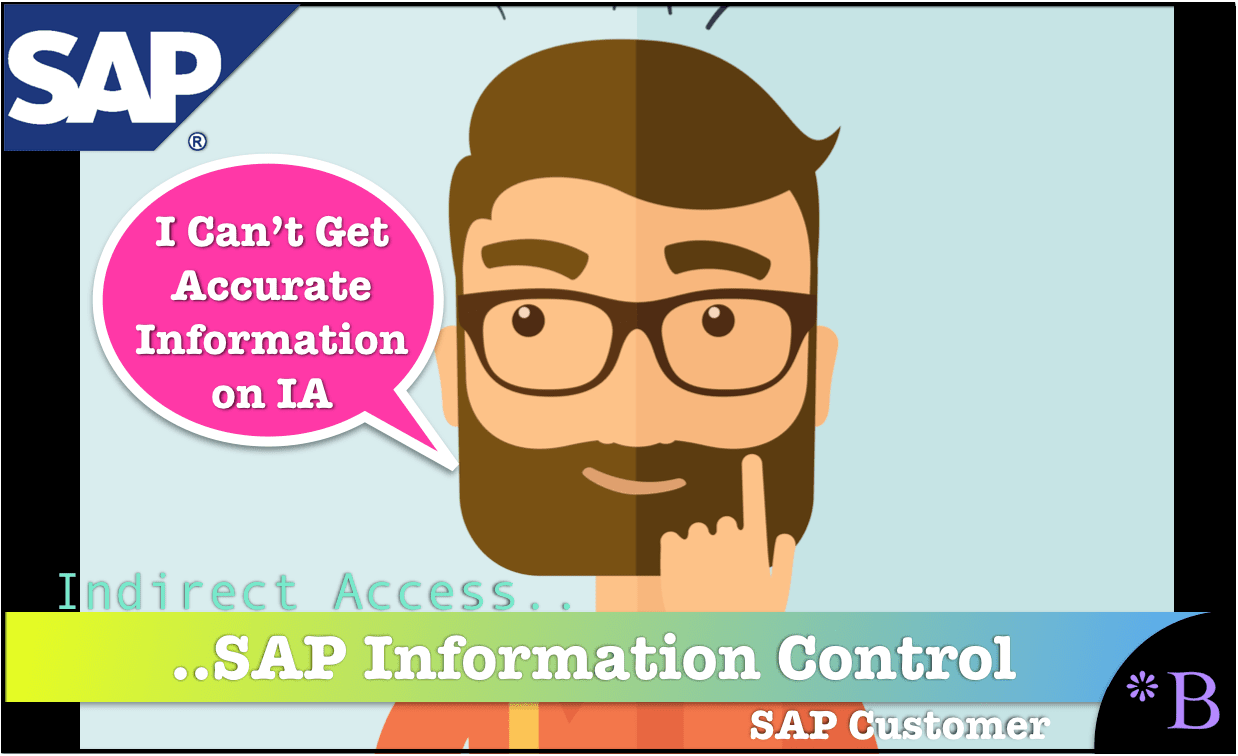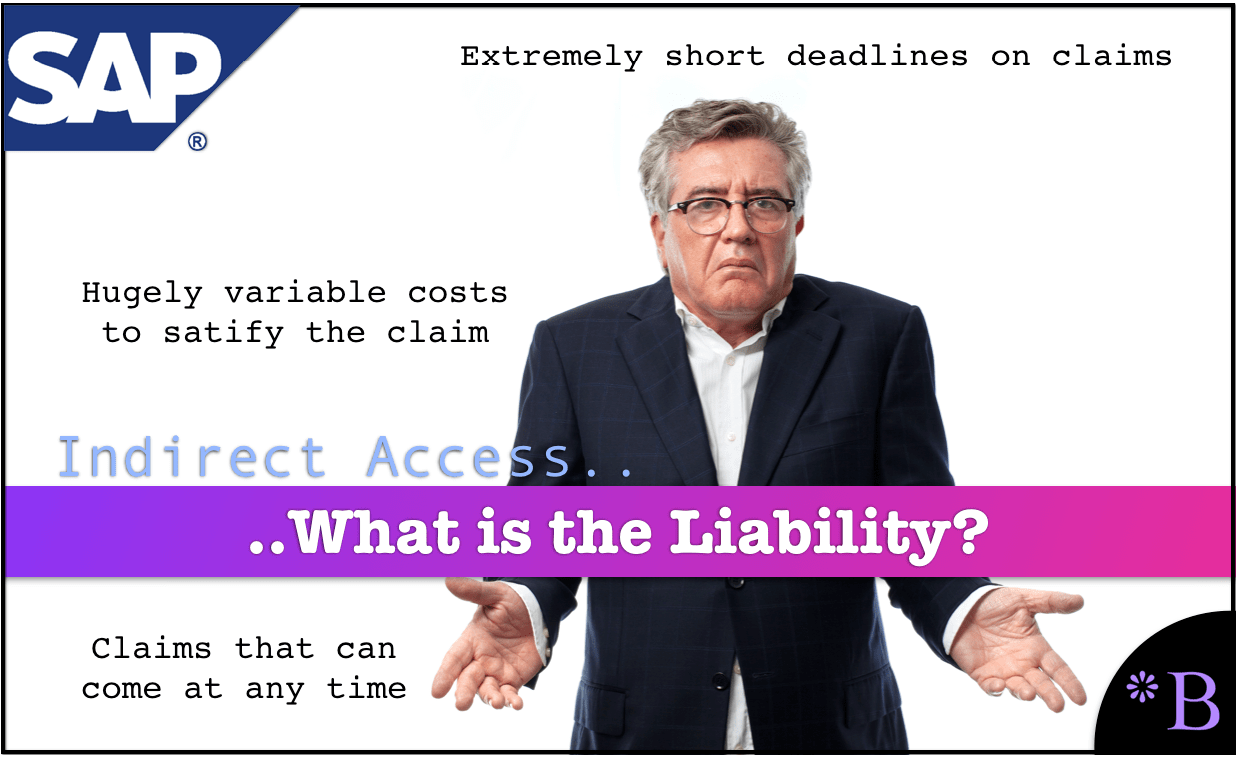An Analysis of JNC’s Article on Indirect Access
Executive Summary
- JNC Consulting published an article on indirect access.
- We analyze the JNC Consulting article for accuracy.

Introduction
As I have researched the area of SAP indirect access, I have made a focus on understanding the advice being offered by companies on this topic. I recently found an article by a consultancy called JNC, so I wanted to see what they had to say on the subject.
I want to preface this article by stating that I don’t know anything about JNC, except they seem to offer advisory services around SAP indirect access. Therefore, I am evaluating only the information they provided in the article without having any feedback on them either way.
Our References for This Article
If you want to see our references for this article and other related Brightwork articles, see this link.
Notice of Lack of Financial Bias: We have no financial ties to SAP or any other entity mentioned in this article.
- This is published by a research entity, not some lowbrow entity that is part of the SAP ecosystem.
- Second, no one paid for this article to be written, and it is not pretending to inform you while being rigged to sell you software or consulting services. Unlike nearly every other article you will find from Google on this topic, it has had no input from any company's marketing or sales department. As you are reading this article, consider how rare this is. The vast majority of information on the Internet on SAP is provided by SAP, which is filled with false claims and sleazy consulting companies and SAP consultants who will tell any lie for personal benefit. Furthermore, SAP pays off all IT analysts -- who have the same concern for accuracy as SAP. Not one of these entities will disclose their pro-SAP financial bias to their readers.
Analysis of JNC’s Article
Indirect Access has been around for a long time, although it has emerged as a hot topic in the SAP licensing world in recent years. With claims for unlicensed Indirect Access usage by SAP reaching into the millions, even tens of millions, organizations can no longer afford to ignore the issue.
When I read this, it seems that JNC is obscuring why indirect access has increased so significantly recently. This increase is not generalized across other software vendors but is specific to SAP. But I can’t decide as at this point it just seems as if there is some beating around the bush.
According to SAP, all usage of the SAP systems needs to be licensed. Indirect Access is a user or third-party application creating, manipulating, or viewing data in the SAP Systems via an interface between the third-party application and SAP. Technically, Indirect access occurs when data communication is executed remotely using SAP’s remote protocol RFC (Remote Function Call). If data is created, manipulated, or viewed in the SAP systems indirectly via a third-party application, that usage needs to be licensed according to SAP’s named-user licensing definitions.
Yes, but what JNC is not questioning is if SAP’s proposal makes any sense.
Does SAP Push False Narratives Designed to Trick People (Hint: Yes)
Let us establish something first. SAP habitual pushes the legality boundaries as well as how it deals with accounts. I continuously have SAP customers, SAP software vendor partners reaching out to me, and explaining various underhanded things that SAP has recently done to them. Therefore, the fact that SAP declares something does not make it accurate. And, in most cases, it makes sense to verify what SAP says because they will lie to gain the advantage. And it should be remembered that no SAP implementation consulting company will help their clients push back on SAP, as they get so many revenues from SAP.
False Information Offered by SAP Consulting Companies with Loyalty to SAP
I find it amusing when a partner from a large SAP consultancy offers their opinions as to what to do with indirect access. These people are entirely petrified of SAP and would not contradict them to save their mother’s life. Mostly what you get from them is some non-helpful advice like doing “due diligence” or “checking your contract.”They have no fiduciary responsibility to their client at the large consulting companies, but they roll out the red carpet for SAP.
So now that we have covered that, let us move into evaluating SAP’s statements.
Let us take this portion of the quote:
“Indirect access is user or third party application creating, manipulating or viewing data in the SAP systems via an interface.”
Well, congratulations, SAP is describing any system to system interaction. Therefore SAP deserves a license sale for any system that is connected to SAP.
How Indirect Access = System Integration
I quote from Dave Blake from UpperEdge.
“(the) Indirect access scenario lies in the ambiguity of the definition of “use” within the agreement. The majority of all agreements never mention the concept of “indirect access” as a means of use. As written, the definition of “use” can be any scenario that activates the processing capabilities of the SAP software. Should unloading or extracting data constitute use? In this sense, how can a SAP customer clearly know when use starts and stops? Furthermore, when it comes to extracting additional license fees, is all use the same? Should there be no consideration taken of the depth of processing capabilities leveraged and the magnitude of the benefit received?”
So if a customer purchased 1000 licenses of Salesforce, it now owes SAP 1000 licenses of ECC. And since it would not make any sense to have special rules for SAP, Salesforce would logically be owed another 1000 licenses because the customer is accessing its system indirectly by connecting it to ERP. That is, the SAP ERP users are accessing Salesforce, and all of this because the two systems were compared.
More from JNC
“There is a notable correlation between the global financial crisis and the emergence of Indirect Access. Firms spending power shrunk, and growth shrinkage resulted in less re-occurring annual licensing demand. With spending power and growth slowing down SAP has had to resort to other revenue streams, and where Indirect Access had historically been low on SAP’s radar, it became a focus. This has also been supported by two key trends. Firstly, the move to interfacing best-of-breed non-SAP applications to SAP, and the emergence of cloud technology and web-based platforms extending the use of SAP out beyond the usual boundaries.”
The first part of this quotation is conjecture. I don’t see any evidence for this, and I don’t know why JNC would come to this conclusion. There is also evidence that points in the opposite direction on this. Let us look at this proposal. The major markets for SAP software are in the US and Europe.
The major markets for SAP software are in the US and Europe.
- The US Economy: In the US, corporate profits are at record levels, which has not recovered since 2007, and 2008 is wages.
- The European Economy: Europe has done less well since 2007 and 2008. Europe’s corporate profits have lagged since the crisis, but they are now actually quite high.
Both economic regions have had low growth rates, but are not a lot different from the pre-2007 and 2008 crisis. Therefore,e it is difficult to see how SAP’s inability to recapture its earlier growth can be laid at the feet of theUS and Europe’s economies.
Other Probable Reasons for SAP’s Revenue Growth Limitations
Market Saturation
SAP has saturated the most significant companies with its product. Secondly, SAP has a limited ability to grow into smaller markets due to SAP’s expense and complexity. SAP representatives will dispute this, of course, by pointing out the number of smaller companies that SAP has as customers. However, the bulk of the revenue of SAP comes from larger companies.
The Declining Expectations of SAP Investments
I have heard and observed is that there is less of an ability to consult companies to pitch very long and expensive multi-year SAP implementations. Companies that purchased SAP ECC systems were told they would see very substantial ROI on their investment. Now no one really can effectively calculate ROI on software, so quantitatively, it’s hard to say. But from working with the software over a long period, it is clear that the ROI from SAP ECC low. A significant reason for this is the cost of maintaining SAP systems is so high. The academic research into ERP systems (not specific to SAP but ERP generally) says the same thing.
What Does the Academic Research into ERP Say?
My book The Real Story Behind ERP is a meta-analysis of all the academic research on this topic up to the book’s publication. This book should not necessarily be seen as an indictment of all ERP. Still, it does indicate that one should watch the budgets of ERP projects more carefully, as they are not a slam dunk to provide a return unless they can be had at a reasonable overall cost. It is widespread to assume that ERP systems must be purchased in all cases. This is not an informed view on the topic.
- Many companies already had ERP functionality in homegrown systems before ERP was introduced, and many maintained these systems at a far lower cost than when they moved to SAP ECC.
- What ERP offers can be improved upon by connecting a financial system to separate supply chain systems, human resource systems, etc.. Each one of them with better functionality in each area than ERP. And there is no evidence that the cost of this architecture is higher than an ERP system. As soon as someone proposes that integration costs are high, I am happy to provide a list of $200 million and more SAP ECC implementations implemented by Deloitte or IBM, and we can discuss the costs of options from that point.
Is ERP the Only Way?
ERP is one path for companies that want a financial system pre-integrated to supply chain and other functionality. Still, it is not the ROI and driver of high standardization within companies that it was proposed initially by Gartner and ERP software vendors. I have been on countless SAP ECC implementations, and the abilities companies receive from having SAP ERP is not a big deal. On the other hand, I have been impressed by many applications in my life. Two vendors that come to mind are Arena Solutions in the bill of materials management and PlanetTogether in production scheduling. The return of those applications is far higher than SAP ERP systems. And it is entirely evident from using and understanding each of the applications above. But because the applications are so easy to use and implement so quickly, not a single major consulting company will recommend either of these applications, because you can’t make much money on the consulting side.
What Happens When SAP ERP Implementations Go Bad?
Also, for companies that fail in an ECC implementation, it has taken down the entire company in quite a few cases. That is a highly expensive and complicated ERP implementation that made that company so weak that a competitor, etc. purchased them.
You generally don’t read about those scenarios in the IT media.
Secondly, the ROI on SAP’s ERP system is probably the best story SAP has. Given the problems, most of SAP’s non-ERP applications have, the lack of improvement in them versus the proposed increase by SAP indicates, the ROI on these non-ERP applications is most probably negative.
Therefore a more reasonable explanation is that customers’ expectations of the benefits of an SAP purchase, while still quite exaggerated, are becoming closer to reality.
The Necessity of Getting Hundreds of Millions in Stock Options Exercised for the Top Executives at SAP
What is clear is that SAP cannot meet its revenue goals through traditional means. Hasso Plattner and Bill McDermott promised Wall Street considerable growth through S/4HANA and HANA. Well, S/4HANA is often given away for free, and HANA is so expensive that it has a reduced market. So these two products are not going to drive sales as predicted by SAP. Therefore it is true that SAP is under revenue pressure.
The “Always There” Premise of Indirect Access
I disagree with JNC’s premise that what SAP has done is move to an interpretation of indirect access that “was always there.” I think instead that SAP enlarged the definition of indirect access to the degree that has never been seen in the history of enterprise software. And I have to emphasize that SAP cannot set up a standard of indirect access that only applies to itself. SAP is a compelling software vendor. However, they are not their legal system. They need to respect the legal systems and the customary ways of doing business in the countries in which they do business. They can’t change the rules when they can’t meet Wall Street’s expectations.
JNC gets into a detailed discussion regarding common questions that they receive. There is some value to this, but my primary qualm with this line of reasoning is around JNC’s assumption. JNC is merely assuming that SAP is right. So if that assumption is not correct, then getting into the details with this assumption is a bit contradictory.
Then JNC answers the question if indirect access claims are negotiable.
Yes, they are! This demonstrates how “flexible” the legality is of SAP’s interpretation of indirect access is. If you buy enough stuff from SAP, there is no indirect access problem. In this way, indirect access can be seen as a pure shakedown play by the SAP account executive.
Conclusion
JNC provides some useful information in the article. They have put a lot of thought into how to offer a service for companies looking for indirect access. One of my issues with companies offering these services is that they are far too respectful of what SAP is doing with indirect access. They are legitimizing the moves that SAP is making with indirect access.
Something I have noticed is a powerful predisposition to create excuses for what SAP is doing. Another obvious thing, but I don’t see being pointed out, iswhy other vendors ares not also doing this? That should be an obvious question that is most often not asked. If SAP’s argument that IA is necessary because of the increase in “machine-to-machine” communication, why don’t other vendors seem to agree and also bring IA (or that is Type 2 IA) claims against their customers.
I have spoken with quite a few software vendors, and they conclude, as I do, that SAP’s new interpretation of indirect merely is unsupportable. In fact, the more a person tends to know about how the software works, the less accepting they will be of SAP’s new interpretation of indirect access.
It is technically indefensible.
So Why Did Diageo Lose?
Some might ask why Diageo lost the case versus SAP if what I say is true. Well, there are some reasons for this. First, I think the judge did not distinguish between what I have called Type One versus Type Two indirect access. I cover Type One versus Type Two indirect access in this article.
Secondly, I have a hard time understanding what the attorneys for Diageo did when they introduced the concept that they used the SAP integration product, SAP PI, to connect the two systems (ECC to Salesforce). That seems to be an entirely irrelevant argument to me as the integration harness used is not the issue; the definition applied by SAP to indirect access was the most relevant issue. And all of the efforts should have gone into arguing against SAP’s new indirect access definition.

The Problem: Secrecy Around Indirect Access
Oracle, SAP, and their consulting partners, ASUG, and the IT media entities all have something in common. They don’t want indirect access understood. Media outlets like Diginomica are paid to distribute PR releases as articles, as we covered in the article SAP’s Recycled Indirect Access Damage Control for 2018. The intent is to lower SAP customers’ concern around indirect access so that indirect access is underestimated, as we covered in the article The Danger in Underestimating SAP Indirect Access.

The primary providers of information in the SAP space are all financially linked to SAP. SAP does not want indirect access understood, so these entities do as they are told by SAP.